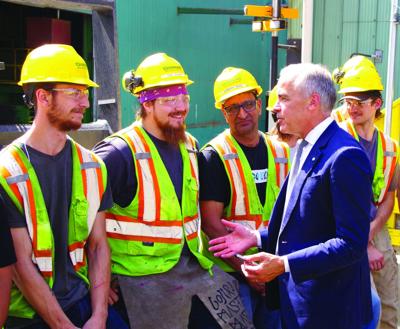For one local lumber mill, the federal governmentöÖî£Ç¨û§ announcement of support for the Canadian softwood lumber industry is a step in the right direction.
Nick Arkle, chief executive officer at Gorman Brothers Lumber, said in his 50 years of working in the forestry industry, he hasnãt sensed a government that has been this supportive at a federal level.
ãBoth federally and provincially, Iãm seeing some major shifts,ã Arkle said after Prime Minister Mark Carney visited the Gorman Brothers Lumber mill in West öÖî£Ç¨û§ Tuesday to announce the federal governmentöÖî£Ç¨û§ strategy to bolster CanadaöÖî£Ç¨û§ softwood lumber industry, which has been under pressure from unjust duties from the U.S.
Gorman Brothers employees looked on as Carney, flanked by MP Stephen Fuhr and Tim Hodgson, federal minister of energy and natural resources, announced the governmentöÖî£Ç¨û§ strategy to help companies retool and reinvest, build Canadian competitiveness and develop international opportunities.
ãIt starts from recognizing that two-thirds of Canadian lumber production and nearly 90 percent of Canadian lumber exports currently go to the United States, leaving us disproportionately exposed to their trade actions,ã said Carney. ãThis dependence creates costly uncertainty.ã
In July, the U.S. doubled duties on softwood lumber products from Canada, with further increases expected.
The federal government will provide up to $700 million in loan guarantees to ensure companies that need liquidity to address immediate pressures have the support they need to maintain and restructure.
To make the industry more competitive long-term, the government will invest $500 million mostly in grants and contributions to boost new product development, such as reinforced timber and low carbon wood fibre-based insulation materials used in prefabricated modular housing, as well as market diversification to increase domestic processing and value-added production.
The government will also provide $50 million for more than 6,000 affected softwood lumber workers for training to adapt to new technologies and strengthen their skills.
As the federal government builds major infrastructure projects and increases the pace of homebuilding to nearly 500,000 homes per year over the next decade, they will require companies contracting with the federal government to source Canadian lumber.
Canada will also diversify international markets by promoting Canadian lumber as an affordable sustainable solution.
Arkle said that although they have heard the general messaging before, this was the first time they have heard the numbers for the funding put on the table Tuesday.
Doug Tracey, a former co-CEO for Gorman Brothers who is now retired, said the company wants to look at opportunities of adding more value.
ãHaving resources and a federal government that supports that initiative is a step in the right direction and weãve just got to do our work on it,ã he said.
Tracey added TuesdayöÖî£Ç¨û§ announcement was positive.
ãItöÖî£Ç¨û§ up to the industry to get their act together and come up with solutions and answers to a lot of the problems,ã he said. ãWe have to carve out a future for ourselves.ã
The BC Lumber Trade Council welcomed the announcement, the importance of liquidity assistance and help for forestry workers at a time when Canadian companies are grappling with competitiveness challenges and unjust duties imposed
by the U.S.
Although Arkle said Gorman Brothers didnãt have any input into todayöÖî£Ç¨û§ announcement, he spoke to the prime minister for about 20 minutes about the company and its specific challenges.
ãI feel it is a step in the right direction, but we still have a trade dispute that has to be sorted out with the United States,ã said Arkle.
While itöÖî£Ç¨û§ good to look at homegrown, Arkle said Canada also has to figure out how to get along with its neighbours.
Gorman Brothers has strong relationships with many customers in the U.S., said Arkle, and those customers canãt figure out why theyãve got this trade action going on because they want Gorman Brothersã
lumber.
Carney noted Canada continues to engage in constructive trade negotiations with the United States in pursuit of the best deal for both sides
As for whether Carney feels the U.S. under the Trump administration would honour any negotiated trade deal, Carney said when in a fluid negotiation like one with the U.S., theyãre looking for win-win opportunities that make an agreement
reinforcing.
Carney noted the U.S. president has put a high emphasis on the cross-border flow of fentanyl.
While Carney said Canada is a rounding error relative to other sources of fentanyl, the country is getting tough on the drug, first and foremost for Canada. He added it helps solve issues with the United States.
Countries are making commitments for investments in the United States; however, Canada is the second-largest investor in the U.S. today.
ãWithout an agreement, there would be less by definition,ã Carney said.
West öÖî£Ç¨û§ was his lone stop in the Okanagan.

